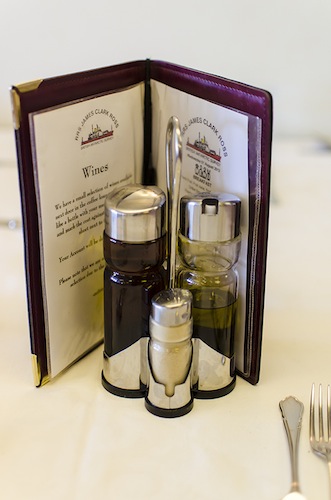Dispatch 3: Life Aboard
31st July 2012
The pioneering British oceanographer John Swallow remarked that a research cruise should be no less than a month in duration. Only then, he said, does one shed the routines and concerns of shoreside life and fully adjust to life at sea. He of course was speaking of the science staff, who come and go, not the professional seamen who remain aboard much longer and on whom, a priori, the science depends; they might see shipboard life in a different context. This crew, the entire complement, has not only been immensely helpful, but warmly welcoming.
 Mirjam Glessmer and Carolina Nobre enjoy the lounge |
I love life aboard research vessels, particularly in the Arctic. I enjoy every aspect, the rational division of responsibility, the esoteric language of the science and the sea, the practiced professional competence of the scientists, technicians, and mariners, the creative self-sufficiency to make things work and to fix them when they don’t. It’s a pleasure to watch. And then there is the social component, the sprawling conversations after dinner in the lounge, for heaven’s sake. The quarters are close, and everyone’s on their best congenial behavior, as they must be. Those who can’t be have probably been asked to find another line of work, though I’ve never met anyone at sea I wasn’t proud to call shipmate. Plus, this is a truly international group, Icelandic, Dutch, Norwegian, German, and American, wide-ranging in age and life experiences. And then there are the British officers and crew, who, if accents were the criteria, would be from about six different countries. Only now, three days into the cruise, can I understand (most of) them.
'One could grow used to this sort of civilized seafaring'
I’ve never sailed on a British ship before. James Clark Ross is clearly a fine one, and she brings certain surprising amenities such as three-course meals described in leather-bound menus and served on spotless tablecloths by a gentleman named Tom as if in a real restaurant. The food, which has been excellent, is prepared by Chief Cook Keith and Second Cook and Baker, an Irishman called, uh, Paddy. One could grow used to this sort of civilized seafaring. And though I probably shouldn’t risk jinxing us by mentioning it, even the weather—flat seas, light winds, and, at this writing, bright sun—has contributed brilliantly to the sweet quality of life. Even now, people appear on deck in shorts and tee shirts eighty miles north of the Arctic Circle. Seems unnatural. Can’t last,…can it?
Now this isn’t to say people have been idle or grown soft in the face of luxury. The science work began two days ago and now proceeds around the clock. Three watches consisting mostly of graduate students, some on their first cruise, operate a basic oceanographic instrument called the CTD, for conductivity-temperature-depth. It measures that all-important water fingerprint of temperature and salinity as well as current velocity, and it captures water samples from predetermined depths.
 Mooring Operations |
The mooring team has also been hard at work. Moorings, that other basic oceanographic tool, consist of a wire suspended vertically between an anchor resting on the seabed and a syntatic-foam float near the surface on which various instruments and sensors are affixed. With some variation, moorings and CTDs measure similar water and current characteristics (salinity, temperature, and velocity), the difference being that moorings remain at fixed positions in the water column gathering data for a year or more, while CTDs are portable, allowing scientists to measure the flow at any point they deem pertinent. With contributions of a total of twelve moorings by the Dutch, Norwegian, Icelandic, and American scientists presently aboard, the flow through the Denmark Strait from Iceland westward onto shallow shelf off of Greenland will have been measured in the long-term for the first time.
I heard an officer during yesterday’s dinner say only half-factiously that the Arctic was sort of a hobby for the James Clark Ross (JCR as she’s commonly called). Like her namesake did, JCR does most of her work in the Antarctic. But we’re not supposed to call her an icebreaker; she’s “ice-strengthened,” capable of overcoming one meter of first-year ice at two knots. Bob, our chief scientist, stresses how fortunate we are to have her for thirty days, allowing us to measure the East Greenland Current close aboard the ice-choked Greenland coast, impossible with a conventional hulled vessel. Speaking for the media team, I’m looking forward to ice travel, but I wouldn’t say that out loud on the bridge.
 CTD Recovery |
So, anyway, we’ll try to persevere under these physically and emotionally stressful conditions, and we’ll keep you posted as we slog on northward in our continuing privation. I think I’ll go take a shower, try to relax.
 |
James Clark Ross, Some Particulars:
Length Overall: 99.04 meters
Beam: 18.85 m.
Full Load Draft: 6.40 m.
Maximum Speed: 15.7 knots
Cruising Speed: 12 knots
Maximum Endurance: 57 days
Complement:
Officers: 12
Crew: 15
Science: 31 maximum
- Dallas
















